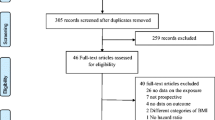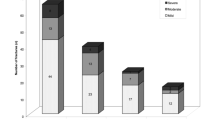Abstract
Summary
This systematic literature review studied the potential association between vertebral fracture risk and vertebral dimensions. Analysis showed that patients with vertebral fractures have smaller non-fractured vertebrae than patients without fractures. Vertebral size is an independent risk factor of vertebral fractures.
Introduction
Biomechanical factors such as vertebral dimensions may be a risk factor for vertebral fractures beside bone mineral density (BMD). The objective of this study was to evaluate potential association of vertebral size and shape with osteoporotic fracture risk through a systematic literature review.
Methods
Systematic analysis of published reports comparing vertebral dimensions of patients with and without osteoporotic fractures was performed. Data sources were electronic databases. Data extraction included methods, site, reproducibility and results of vertebral measurement, study population characteristics. It was noted if populations were matched or data were adjusted for age, height, weight and BMD.
Results
Of 634 reports identified by the literature search, the final review included 13 reports studying 4,428 women and 508 men; median age 64.2 years [range 51.7%–73.0%]. Measurements were performed with computed tomography scan, X-ray, or dual energy X-ray absorptiometry. Vertebral body height, width, depth, area, cross-sectional area (CSA), and volume were 5.5% to 9.5% smaller in fractured group than control group. After adjustment for confounding factors, area, CSA and volume were, respectively, 10.2% [range 7.1%–13.3%], 7.7% [range 1.2%–14.2%] and 9.5% [8.5%–10.5%] smaller in fractured group.
Conclusions
Vertebral size should be considered as a potential independent vertebral fracture risk factor.

Similar content being viewed by others
References
Melton LJ 3rd, Kan SH, Frye MA et al (1989) Epidemiology of vertebral fractures in women. Am J Epidemiol 129:1000–1011
Sievanen H, Kannus P, Nieminen V et al (1996) Estimation of various mechanical characteristics of human bones using dual energy X-ray absorptiometry: methodology and precision. Bone 1817S–1827S
Odvina CV, Wergedal JE, Libanati CR et al (1988) Relationship between trabecular vertebral body density and fractures: a quantitative definition of spinal osteoporosis. Metabolism 37:221–228
Briggs AM, Greig AM, Wark JD et al (2004) A review of anatomical and mechanical factors affecting vertebral body integrity. Int J Med Sci 1:170–180
Gilsanz V, Boechat MI, Gilsanz R et al (1994) Gender differences in vertebral sizes in adults: biomechanical implications. Radiology 190:678–682
Brinckmann P, Biggemann M, Hilweg D (1989) Prediction of the compressive strength of human lumbar vertebrae. Spine 14:606–610
Schultz AB, Andersson GB (1981) Analysis of loads on the lumbar spine. Spine 6:76–82
Faulkner KG, Cummings SR, Black D et al (1993) Simple measurement of femoral geometry predicts hip fracture: the study of osteoporotic fractures. J Bone Miner Res 8:1211–1217
Peacock M, Turner CH, Liu G et al (1995) Better discrimination of hip fracture using bone density, geometry and architecture. Osteoporosis Int 5:167–173
Nieves JW, Formica C, Ruffing J et al (2005) Males have larger skeletal size and bone mass than females, despite comparable body size. J Bone Miner Res 20:529–535
Duan Y, Wang XF, Evans A, Seeman E (2005) Structural and biomechanical basis of racial and sex differences in vertebral fragility in Chinese and Caucasians. Bone 36:987–998
Wu XP, Liao EY, Liu SP et al (2004) Relationship of body surface area with bone density and its risk of osteoporosis at various skeletal regions in women of mainland China. Osteoporosis Int 15:751–759
Duan Y, Seeman E, Turner CH (2001) The biomechanical basis of vertebral body fragility in men and women. J Bone Miner Res 16:2276–2283
Duan Y, Turner CH, Kim BT, Seeman E (2001) Sexual dimorphism in vertebral fragility is more the result of gender differences in age-related bone gain than bone loss. J Bone Miner Res 16:2267–2275
Krolner B (1982) Osteoporosis and normality: how to express the bone mineral content of lumbar vertebrae. Clin Physiol 2:139–146
Nielsen SP, Hermansen F, Barenholdt O (1993) Interpretation of lumbar spine densitometry in women with fractures. Osteoporosis Int 3:276–282
Mazess RB, Barden H, Mautalen C, Vega E (1994) Normalization of spine densitometry. J Bone Miner Res 9:541–548
Ito M, Ohki M, Hayashi K et al (1997) Relationship of spinal fracture to bone density, textural, and anthropometric parameters. Calcif Tissue Int 60:240–244
Ross PD, Huang C, Davis JW, Wasnich RD (1995) Vertebral dimension measurements improve prediction of vertebral fracture incidence. Bone 16:257S–262S
Sone T, Tomomitsu T, Miyake M et al (1997) Age-related changes in vertebral height ratios and vertebral fracture. Osteoporosis Int 7:113–118
Vega E, Ghiringhelli G, Mautalen C et al (1998) Bone mineral density and bone size in men with primary osteoporosis and vertebral fractures. Calcif Tissue Int 62:465–469
Duan Y, Parfitt A, Seeman E (1999) Vertebral bone mass, size, and volumetric density in women with spinal fractures. J Bone Miner Res 14:1796–1802
Link TM, Doren M, Lewing G et al (2000) Cross-sectional area of lumbar vertebrae in peri- and postmenopausal patients with and without osteoporosis. Osteoporosis Int 11:304–309
Seeman E, Duan Y, Fong C, Edmonds J (2001) Fracture site-specific deficits in bone size and volumetric density in men with spine or hip fractures. Bone Miner Res 16:120–127
Deng HW, Xu FH, Davies KM et al (2002) Differences in bone mineral density, bone mineral content, and bone areal size in fracturing and non-fracturing women, and their interrelationships at the spine and hip. J Bone Miner Metab 20:358–366
Biggemann M, Hilweg D, Brinckmann P (1988) Prediction of the compressive strength of vertebral bodies of the lumbar spine by quantitative computed tomography. Skeletal Radiol 17:264–269
Edmondston SJ, Singer KP, Day RE et al (1997) Ex vivo estimation of thoracolumbar vertebral body compressive strength: the relative contributions of bone densitometry and vertebral morphometry. Osteoporosis Int 7:142–148
Johnell O, O’Neill T, Felsenberg D et al (1997) Anthropometric measurement and vertebral deformities. European Vertebral Osteoporosis Study (EVOS) Group. Am J Epidemiol 146:287–293
Carter DR, Bouxsein ML, Marcus R (1992) New approaches for interpreting projected bone densitometry data. J Bone Miner Res 7:137–145
Seeman E, Hopper JL, Bach LA et al (1989) Reduced bone mass in daughters of women with osteoporosis. N Engl J Med 320:554–558
Mosekilde L (1989) Sex differences in age-related loss of vertebral trabecular bone mass and structure biomechanical consequences. Bone 10:425–432
Acknowledgment
Abbott France pharmaceutical company provided project support. The authors have no financial interest in the subject matter or materials discussed in the manuscript. The authors have no conflict of interest.
Author information
Authors and Affiliations
Corresponding author
Rights and permissions
About this article
Cite this article
Ruyssen-Witrand, A., Gossec, L., Kolta, S. et al. Vertebral dimensions as risk factor of vertebral fracture in osteoporotic patients: a systematic literature review. Osteoporos Int 18, 1271–1278 (2007). https://doi.org/10.1007/s00198-007-0356-6
Received:
Accepted:
Published:
Issue Date:
DOI: https://doi.org/10.1007/s00198-007-0356-6




